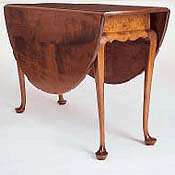ANSWER: I hate to burst your bubble, but your table isn’t an antique. In fact, coffee tables are a modern invention. No one knows exactly where they came from or who designed the first one.
The current definition a coffee table is a low, wide table placed in front of a couch or sofa to receive drinks, TV remotes, magazines, ashtrays, and miscellaneous other items, including feet. Yes, some people do prop their tired feet up once in a while. But a quick look back in time doesn't show many similar tables in our Western history. Old photos of late Victorian room settings show taller tables, often placed behind a sofa to receive cups and glasses when not in use. The only other table offering close to the service of a coffee table was the parlor table, often placed in the middle of the room with a gas lamp on it. Here, the lady of the house could serve coffee or tea to guests.
During the latter half of the 19th century, wealthy people became interested in the exotic furniture of Turkey. They would set up a special corner or an entire room using pillowed benches and ornately carved, low, round tables from which they drank strong Turkish coffee and tea. Americans became especially fond of Japanese design after the Philadelphia Centennial Exposition in 1876. They particularly liked the idea of sitting on pillows on the floor and eating at low tables like the Japanese do. When the Aesthetic Movement took hold in the 1880s, furniture designers blended Eastlake and Renaissance Revival styles with Turkish and Asian ones.
Americans became especially fond of Japanese design after the Philadelphia Centennial Exposition in 1876. They particularly liked the idea of sitting on pillows on the floor and eating at low tables like the Japanese do. When the Aesthetic Movement took hold in the 1880s, furniture designers blended Eastlake and Renaissance Revival styles with Turkish and Asian ones.
While some sources note the production of low tables in various Revival styles during the last decade of the 1800s, no one has ever seen any. The coffee table appeared in the 20th century, most likely in the 1920s and 1930s. As Americans began to purchase parlor sets, consisting of perhaps a couch, two chairs, and several small tables, the coffee table idea became more popular.
The coffee table appeared in the 20th century, most likely in the 1920s and 1930s. As Americans began to purchase parlor sets, consisting of perhaps a couch, two chairs, and several small tables, the coffee table idea became more popular.
In 1903, F. Stuart Foote founded the Imperial Furniture Company in Grand Rapids, Michigan. He had learned the furniture business from his father, E. H. Foote, who had founded the Grand Rapids Chair Company in 1872. Foote claimed to have invented the coffee table himself while helping his wife prepare for a party. He simply lowered the legs on an existing table, and a new type of furniture came into being. Unfortunately, so far this hasn’t been proven.
Prohibition may have also played a role in the development of the coffee table. From 1920 to 1933, America was legally "dry." That led to a shortage of well blended, smooth tasting liquor. “Bathtub gin" and "white lightning" to the place of traditional spirits but both had quite a kick. To soften that kick, people began mixing fruit juices and other beverages with the hootch which eventually led to the invention of the "cocktail." During Prohibition, people often used this low table to serve coffee to their guests. But with the repeal of the law, they could once again legally serve cocktails, so it became known as a “cocktail table.” Sales for these low tables soared even during the Depression.
During Prohibition, people often used this low table to serve coffee to their guests. But with the repeal of the law, they could once again legally serve cocktails, so it became known as a “cocktail table.” Sales for these low tables soared even during the Depression.
To make them seem older than they were and thus more elegant, many furniture manufacturers began producing their coffee/cocktail tables using stylized designs of the past. This was a direct result of the appearance of the Colonial Revival style of the early 20th century which encouraged furniture makers to create pieces in supposedly “colonial” styles. All of a sudden coffee tables appeared in the Queen Anne, Chippendale, Federal, and even Jacobean styles. Thus, many people today are fooled into thinking that their coffee tables are really antiques.
The only way to have a truly antique coffee table is to cut down an existing antique table as F. Stuart Foote did in 1903. And while your coffee table will be a true antique, it won’t be worth very much.
To read more articles on antiques, please visit the Antiques Articles section of my Web site. And to stay up to the minute on antiques and collectibles, please join the over 30,000 readers by following my free online magazine, #TheAntiquesAlmanac. Learn more about the Sears Catalogue and the items sold in it in "Sears' Book of Bargains" in the 2021 Fall Edition, online now. And to read daily posts about unique objects from the past and their histories, like the #Antiques and More Collection on Facebook.











